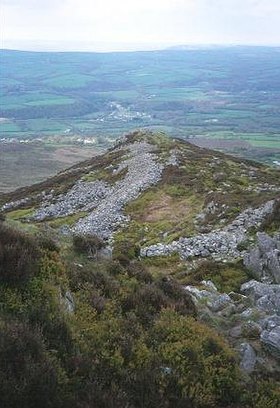Mynydd Carningli
| Mynydd Carningli | |
|---|---|

Mynydd Carningli
|
|
| Highest point | |
| Elevation | 346 m (1,135 ft) |
| Prominence | 232 m (761 ft) |
| Parent peak | Foel Cwmcerwyn |
| Listing | Marilyn |
| Naming | |
| Translation | Angel–rock mountain (Welsh) |
| Pronunciation | Welsh: [ˈmənɪð karˈnɪŋli] |
| Geography | |
| Location | Pembrokeshire, Wales |
| Parent range | Preseli Hills |
| OS grid | SN062371 |
| Topo map | OS Landranger 145 |
| Geology | |
| Last eruption | 450 million years ago |
Mynydd Carningli is a mountain in the Preseli Hills near the town of Newport, Pembrokeshire, Wales. It has both prehistoric and historic remains.
Carningli (or Carn Ingli) is 347 metres (1,138 ft) high. Close to the coast, it dominates the surrounding countryside. It is easy to climb but has a rocky summit and a steep scree slope on its southern and eastern flanks. It is a biological SSSI.
The summit features a large and prominent archeological site; one of the largest hillforts in west Wales. This hillfort, generally dated to the Iron Age and assumed to be from the first millennium BC. It covers an area of about 4 ha, and is about 400 m x 150 m in extent. The lower slopes of Carningli are covered with traces of Bronze Age settlement (Pearson 2001) and so some features of the hillfort may be even older. Although not one of the largest fortified sites in Wales, it is certainly one of the most complex, incorporating a series of substantial stone embankments, natural rock cliffs and scree slopes which may have been used as natural defences. Inside and outside the embankments are terraced enclosures, hut circles and rectangles. Approximately 25 hut circles are at the north east end of the site. On the other side are three enclosures separated by embankments. Beneath the scree slope on the eastern flank of the mountain are two further massive defensive embankments. The only plan is that of Hogg 1973 - it has been modified by Figgis, and again in recent research by Brian John. According to Hogg, there are signs that some of the defensive embankments and walls had been intentionally demolished, which he attributed as "evidence for systematic destruction by Roman invaders in the aftermath of the conquest of Wales". The Royal Commission on the Ancient and Historical Monuments of Wales noted in 2009 that "Such a dramatic interpretation, placing the Roman legions on the slopes of Carn-ingli in an attack on its inhabitants, might be questioned today".
There are records of intermittent occupation of the site in the Age of the Saints, and as recently as the Middle Ages. No comprehensive excavations of the hillfort have been made.
...
Wikipedia
